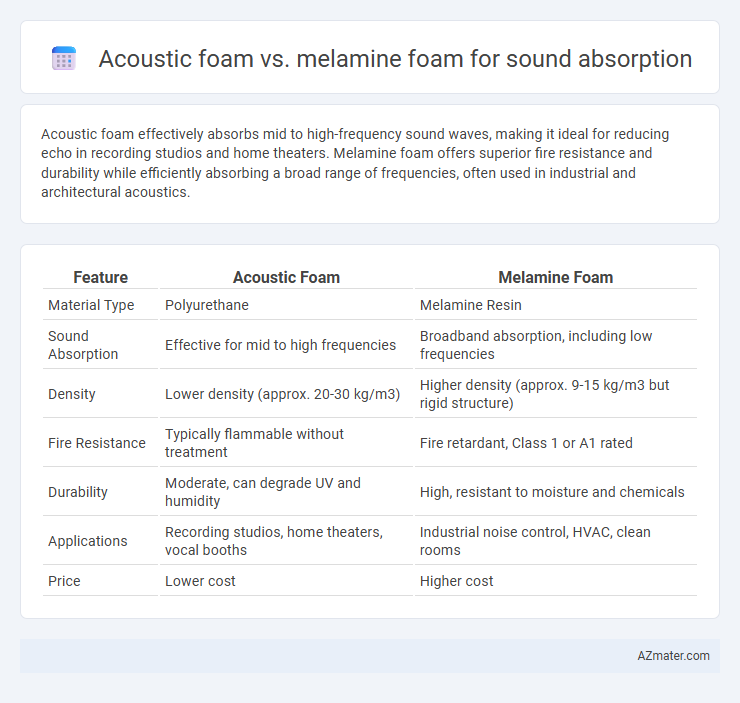Acoustic foam effectively absorbs mid to high-frequency sound waves, making it ideal for reducing echo in recording studios and home theaters. Melamine foam offers superior fire resistance and durability while efficiently absorbing a broad range of frequencies, often used in industrial and architectural acoustics.
Table of Comparison
| Feature | Acoustic Foam | Melamine Foam |
|---|---|---|
| Material Type | Polyurethane | Melamine Resin |
| Sound Absorption | Effective for mid to high frequencies | Broadband absorption, including low frequencies |
| Density | Lower density (approx. 20-30 kg/m3) | Higher density (approx. 9-15 kg/m3 but rigid structure) |
| Fire Resistance | Typically flammable without treatment | Fire retardant, Class 1 or A1 rated |
| Durability | Moderate, can degrade UV and humidity | High, resistant to moisture and chemicals |
| Applications | Recording studios, home theaters, vocal booths | Industrial noise control, HVAC, clean rooms |
| Price | Lower cost | Higher cost |
Introduction to Sound Absorbing Materials
Acoustic foam and melamine foam are widely used sound absorbing materials in acoustic treatment due to their porous structures that trap sound waves and reduce reverberation. Acoustic foam typically consists of polyurethane and features pyramid or wedge shapes designed to increase surface area and maximize sound absorption, primarily effective in mid to high-frequency ranges. Melamine foam, a lightweight resin-based material, offers flame resistance and better performance in suppressing a broader spectrum of frequencies, making it suitable for environments demanding both acoustic control and fire safety.
What is Acoustic Foam?
Acoustic foam is a porous, open-cell material designed to absorb sound waves and reduce echo and reverberation in various environments. It is typically made from polyurethane and features wedge, pyramid, or egg-crate shapes to maximize surface area and enhance sound absorption effectiveness. Unlike melamine foam, acoustic foam is specifically engineered for superior acoustic performance in studios, theaters, and recording booths.
What is Melamine Foam?
Melamine foam is a lightweight, open-cell material known for its excellent sound absorption properties, commonly used in acoustic treatment to reduce noise and reverberation. Unlike traditional polyurethane acoustic foam, melamine foam offers superior fire resistance, durability, and thermal insulation, making it suitable for commercial and industrial environments. Its fine porous structure effectively traps sound waves, enhancing acoustic performance in studios, offices, and auditoriums.
Acoustic Performance: Acoustic Foam vs Melamine Foam
Acoustic foam offers superior sound absorption in mid to high-frequency ranges, making it ideal for reducing echo and reverberation in recording studios and home theaters. Melamine foam excels at absorbing a broader spectrum of frequencies, including low frequencies, due to its open-cell microstructure and higher density. The choice between acoustic foam and melamine foam depends on the specific acoustic treatment needs, with melamine foam providing enhanced performance in challenging environments requiring effective bass trapping.
Fire Safety and Heat Resistance Comparison
Acoustic foam, typically made from polyurethane, offers moderate fire resistance but can release toxic fumes when burned, whereas melamine foam possesses superior fire safety properties with high flame retardancy and low smoke emission. Melamine foam withstands higher temperatures without degrading, making it more effective for applications requiring heat resistance and compliance with stringent fire safety standards. In fire-sensitive environments, melamine foam is preferred over acoustic foam due to its enhanced thermal stability and reduced risk of flammability.
Durability and Lifespan
Acoustic foam, typically made from polyurethane, offers a balanced combination of sound absorption and durability, with a lifespan of around 5 to 10 years depending on environmental factors such as humidity and exposure to sunlight. Melamine foam, known for its rigid open-cell structure, tends to maintain its acoustic properties longer, often exceeding 10 years, and demonstrates superior resistance to heat, moisture, and microbial growth compared to acoustic foam. The choice between acoustic foam and melamine foam depends on the specific application's durability requirements and environmental conditions influencing lifespan.
Applications in Different Environments
Acoustic foam excels in recording studios, home theaters, and vocal booths due to its high sound absorption and ease of shaping into wedge or pyramid patterns, effectively reducing mid to high-frequency noise. Melamine foam is favored in industrial settings and large open spaces for its fire resistance, lightweight structure, and superior performance in absorbing a broad frequency range, including low frequencies. Both materials are selected based on environmental demands such as fire codes, acoustic goals, and installation complexity, ensuring optimal sound control across diverse applications.
Cost and Budget Considerations
Acoustic foam generally offers a more affordable solution for sound absorption compared to melamine foam, making it ideal for budget-conscious projects. Melamine foam, despite its higher cost, provides superior fire resistance and durability, which can justify the investment in safety-critical environments. Evaluating the total cost of ownership, including performance and longevity, helps determine the best value between these two sound-absorbing materials.
Installation and Maintenance
Acoustic foam offers straightforward installation with adhesive backing or mounting clips, making setup quick and user-friendly, while Melamine foam often requires careful cutting and securing due to its rigid structure. Both materials demand minimal maintenance, but Melamine foam's open-cell design resists dust accumulation better than the softer, more porous Acoustic foam. In environments prone to humidity or heavy use, Melamine foam maintains its shape and acoustic performance longer, reducing the need for frequent replacement or cleaning.
Which Foam is Best for Your Needs?
Acoustic foam excels at reducing mid to high-frequency noise, making it ideal for music studios and vocal booths, whereas melamine foam offers superior fire resistance and durability with effective absorption across a broader frequency range, suitable for industrial and commercial environments. The choice depends on your specific sound absorption needs, budget, and environmental safety requirements, with acoustic foam being more affordable and melamine foam providing enhanced performance in demanding conditions. For targeted soundproofing, prioritize acoustic foam, but for comprehensive acoustic treatment and safety, melamine foam is the best option.

Infographic: Acoustic foam vs Melamine foam for Sound absorber
 azmater.com
azmater.com